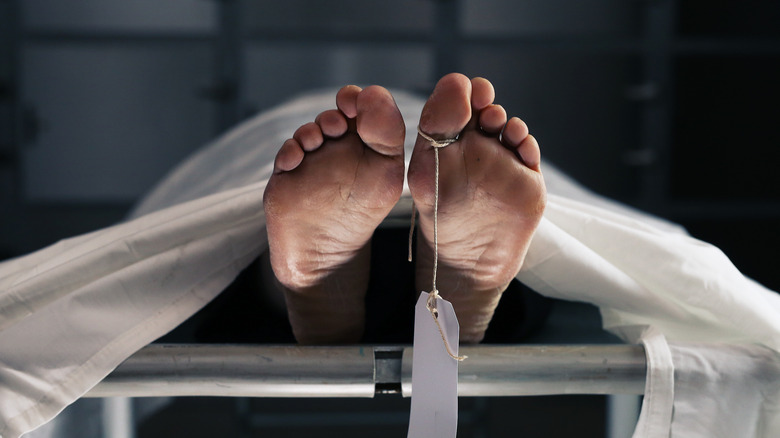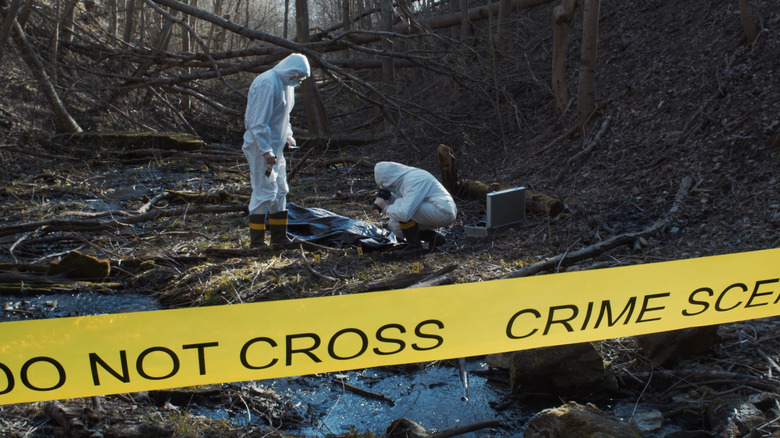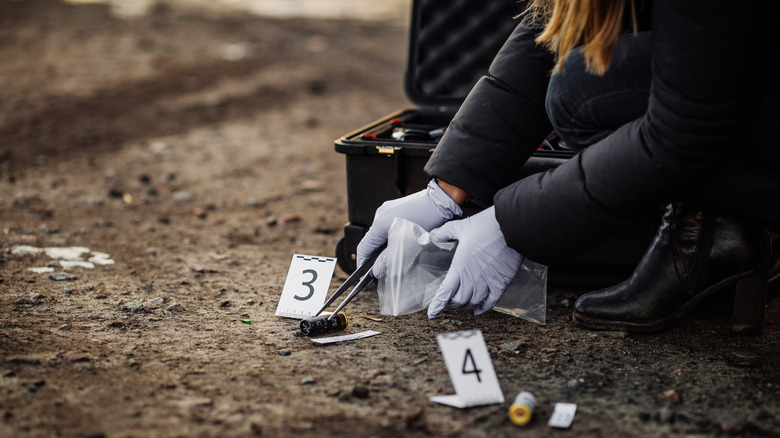Disturbing Details Found In Katherine Hall's Autopsy Report
The following article includes descriptions of graphic and violent imagery.
The late '90s and early 2000s were a chilling time for people living in Baton Rouge, Louisiana. The Daily Mirror reports that between 1994 and 2004, a serial killer stalked the streets and left a string of gruesome murders behind him. The murders exhibited similar tactics ranging from chilling dismemberment to a particular placement pattern of the bodies. Still, when investigators probed for leads, all they could initially uncover was the tread of a Goodyear Aquatred 3 tire, an automotive accessory that, according to Oxygen True Crime, matched up with the vehicles of approximately 100 local residents.
Bodies continued to be discovered as leads turned cold and innocent names were cleared of suspicion. In the spring of 2004, law enforcement happened upon the residence of 41-year-old Sean Vincent Gillis, an unemployed white male with previous arrests for drunk driving on his record (via NBC News). At first, Gillis seemed cooperative, going so far as to consent to DNA analysis and police questioning. But when it was revealed that Gillis' DNA sample matched those found on several victims, the accused man broke down and confessed.
During a videotaped interview with law enforcement officials, Sean Vincent Gillis declared himself a "monster," and the shocking details found in Katherine Hall's autopsy report — a woman identified as one of his victims — support that claim.
Post-mortem stab wounds reveal a shocking truth
When 29-year-old Katherine Hall's cold dead body was uncovered near a Baton Rouge-based construction site, it was clear she had been murdered. Oxygen True Crime reports that her body was viciously and repeatedly stabbed. However, further scrutiny showed no traces of blood within the vicinity of where her body was discovered. This indicated the stabbing took place after the victim died, perhaps as a kind of ritualistic action or even a self-conducted autopsy performed by the killer himself.
This finding led forensic psychologist Joni Johnston to conclude that "the actual kill is not as sexy to him as what happens after." Based on this aspect of the autopsy report, Johnston presumed, "He's attracted to and seeking out body parts of these dead corpses, which is beyond rare." According to True Crime Daily, serial killer Sean Vincent Gillis didn't stab his victims to kill them. Rather, he used nylon zip-ties to asphyxiate them. It would appear that he took a twisted and perverted pleasure in slicing the body after the murder took place, leaving her so wounded that bone was visible through her leg. The violent acts Gillis committed against these women after they died were even more disturbing.
Katherine Hall's body was placed in a sadistic location and position
The gruesome murder of Katherine Hall could not have been mistaken for a moment of rage or a lover's quarrel gone horribly wrong. According to True Crime Daily, officers were pretty certain they had a serial killer on their hands as soon as they saw Hall's body, a fact that brought a devastating blow to Baton Rouge, which had already been plagued by the violence of a different serial killer named Derrick Todd Lee. With Lee behind bars and serial killing presumed to be a dark page in Louisiana's past, the gory display of Hall's lifeless body on January 4, 1999, provoked new fears (via the Daily Mirror).
There at the end of a winding, rustic backroad was Katherine Hall's body. She had been displayed naked, stabbed, strangled, and positioned beneath a street sign marked "dead end." The dark and twisted scene on public display took an even more sinister turn once law enforcement officials realized that her eyelids had been removed (per Oxygen True Crime).
Her eyelids were removed and taken
According to Oxygen True Crime, investigator Todd Morris of Louisiana's attorney general's office told reporters that Sean Vincent Gillis further mutilated Katherine Hall's body by taking her eyelids. This gruesome detail was noted despite the fact that other identifying objects, such as her jacket and identification card, were left behind, scattered a stretch away from where the body was placed.
In a separate piece, Oxygen True Crime reports that serial killers often leave crime scenes with "trophies" in hand. These horrifying keepsakes can be anything from a patch of hair to a piece of clothing or, in this case, a pair of eyelids taken from the victim. Theories abound as to why they engage in this kind of behavior, with many experts believing they are either asserting skill or reliving a sick and twisted fantasy. Nicole Mott, who penned "Encyclopedia of Murder and Violent Crime," has hypothesized there might be a sexual component to these trophies.
While unsettling, the latter theory lines up with former FBI Criminal Profiler Mary Ellen O'Toole's assessment. She described Hall's killer as "sexually deviant," and further evidence from the autopsy report shows that statement rings true (via True Crime Daily).
Pubic hair was placed in her mouth
Undoubtedly the most disturbing detail was the one that ultimately led to Sean Vincent Gillis' arrest and eventual conviction (via Oxygen True Crime). The DNA analysis showed Gillis was a match for a public hair found in Katherine Hall's mouth. According to True Crime Daily, while this was evidence that he likely had sex with his victims in a post-mortem state, it was also evidence of his guilt that could be used against him in court.
Sean Vincent Gillis is currently serving life in prison for these heinous, unspeakable acts of aggression committed against Katherine Hall and several other people. In a letter to his devastated wife reported by WABF 9 News, Gillis writes regarding another victim named Donna Bennett Johnston, "There were no advances, sex was not my intent ... I was pure evil that night."




